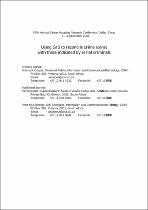JavaScript is disabled for your browser. Some features of this site may not work without it.
- ResearchSpace
- →
- Research Publications/Outputs
- →
- Conference Publications
- →
- View Item
| dc.contributor.author |
Cooper, Antony K

|
|
| dc.contributor.author |
Byleveld, P

|
|
| dc.contributor.author |
Schmitz, P

|
|
| dc.date.accessioned | 2009-01-09T07:02:45Z | |
| dc.date.available | 2009-01-09T07:02:45Z | |
| dc.date.issued | 2001-12 | |
| dc.identifier.citation | Cooper, AK, Byleveld, P and Schmitz, PMU. 2001. Using GIS to reconcile crime scenes with those indicated by serial criminals. Crime Mapping Research, 5th Annual International Conference, Dallas, Texas, USA, 1-4 December 2001, pp 6 | en |
| dc.identifier.uri | http://hdl.handle.net/10204/2779 | |
| dc.description.abstract | Sometimes, when serial criminals are caught, they admit to their crimes and are willing to point out crime scenes to the police. The South African Police Service (SAPS) then sends independent police officers with the suspect to document those locations he indicates. The CSIR has been assisting detectives and prosecutors to prepare selected cases for court, by compiling maps of the relevant details, which enhance the ability of the court to follow the proceedings of a complex case. For serial criminals, they show the crime scenes attributed to the suspect, those indicated by the suspect, and the routes taken by the suspect with the independent officers. When compiling such maps, great care needs to be taken over the accuracy of the data, which includes revisiting the scenes with a GPS receiver to record their coordinates. This quality assurance highlights discrepancies between the crime scenes described in case dockets and those the suspect pointed out, allowing the investigators to link additional dockets to the suspect. It also highlights any errors there might be in the compilation of the original dockets, allowing the prosecutor to present a better case to the court. This paper describes how crime mapping and analysis can be used to link unsolved case dockets to a suspected serial criminal, and how it can be used to enhance the quality of a case for presentation in court. | en |
| dc.language.iso | en | en |
| dc.subject | Crime mapping | en |
| dc.subject | Analysis capabilities | en |
| dc.subject | Geographical information systems | en |
| dc.subject | GIS | en |
| dc.subject | Cellular telephone conversations | en |
| dc.title | Using GIS to reconcile crime scenes with those indicated by serial criminals | en |
| dc.type | Conference Presentation | en |
| dc.identifier.apacitation | Cooper, A. K., Byleveld, P., & Schmitz, P. (2001). Using GIS to reconcile crime scenes with those indicated by serial criminals. http://hdl.handle.net/10204/2779 | en_ZA |
| dc.identifier.chicagocitation | Cooper, Antony K, P Byleveld, and P Schmitz. "Using GIS to reconcile crime scenes with those indicated by serial criminals." (2001): http://hdl.handle.net/10204/2779 | en_ZA |
| dc.identifier.vancouvercitation | Cooper AK, Byleveld P, Schmitz P, Using GIS to reconcile crime scenes with those indicated by serial criminals; 2001. http://hdl.handle.net/10204/2779 . | en_ZA |
| dc.identifier.ris | TY - Conference Presentation AU - Cooper, Antony K AU - Byleveld, P AU - Schmitz, P AB - Sometimes, when serial criminals are caught, they admit to their crimes and are willing to point out crime scenes to the police. The South African Police Service (SAPS) then sends independent police officers with the suspect to document those locations he indicates. The CSIR has been assisting detectives and prosecutors to prepare selected cases for court, by compiling maps of the relevant details, which enhance the ability of the court to follow the proceedings of a complex case. For serial criminals, they show the crime scenes attributed to the suspect, those indicated by the suspect, and the routes taken by the suspect with the independent officers. When compiling such maps, great care needs to be taken over the accuracy of the data, which includes revisiting the scenes with a GPS receiver to record their coordinates. This quality assurance highlights discrepancies between the crime scenes described in case dockets and those the suspect pointed out, allowing the investigators to link additional dockets to the suspect. It also highlights any errors there might be in the compilation of the original dockets, allowing the prosecutor to present a better case to the court. This paper describes how crime mapping and analysis can be used to link unsolved case dockets to a suspected serial criminal, and how it can be used to enhance the quality of a case for presentation in court. DA - 2001-12 DB - ResearchSpace DP - CSIR KW - Crime mapping KW - Analysis capabilities KW - Geographical information systems KW - GIS KW - Cellular telephone conversations LK - https://researchspace.csir.co.za PY - 2001 T1 - Using GIS to reconcile crime scenes with those indicated by serial criminals TI - Using GIS to reconcile crime scenes with those indicated by serial criminals UR - http://hdl.handle.net/10204/2779 ER - | en_ZA |






